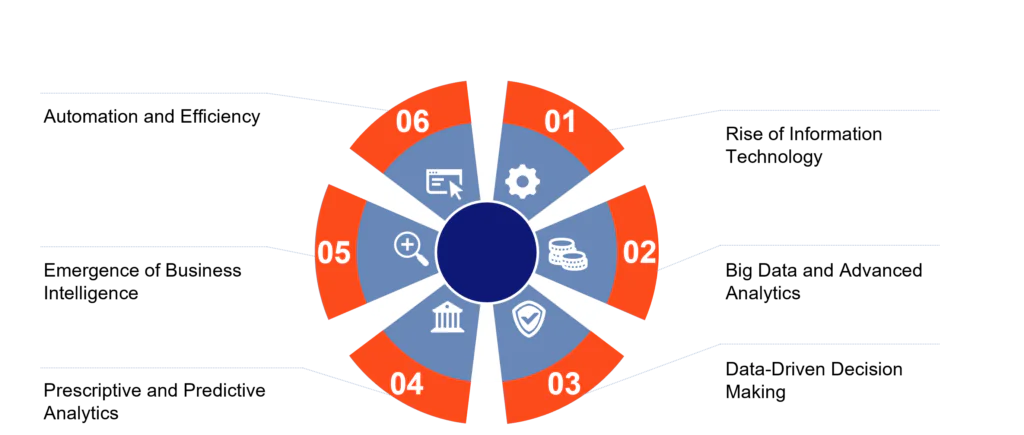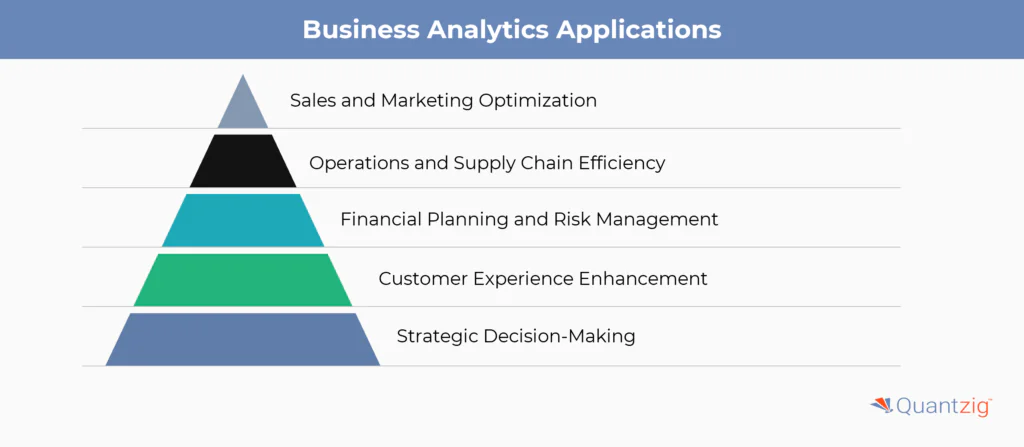Author: Associate Vice President, Analytics and Data Strategy, Quantzig.
Table of Contents
Introduction to Benefits of Business Analytics
In today’s fast-paced business environment, innovative technological solutions are propelling organizations toward greater efficiency and success. Business analytics has emerged as a crucial element in this transformation, evolving from merely presenting facts and figures to providing comprehensive business intelligence. This advanced analytics field now plays a pivotal role in predicting outcomes and aiding future decision-making. The article will explore the benefits of business analytics, emphasizing how it leverages technologies like predictive analytics, data mining, and machine learning to drive positive business outcomes and optimize organizational performance.
Book a demo to experience the meaningful insights we derive from data through our analytical tools and platform capabilities. Schedule a demo today!
Request a Free DemoWhat is Business Analytics?
Business analytics refers to the skills, technologies, and best practices that empower organizations to iteratively explore and investigate past business performance to gain insights that help drive future business outcomes. Companies use business analytics for data-driven and smart decision making. Business analytics helps companies derive the desired outcome for businesses. It also enables companies to optimize and automate business processes and achieve a competitive advantage by offering insights that help them to:
- Explore data and find new patterns
- Conduct statistical and qualitative analysis effectively and explain the reasoning to certain results
- Validate previous decisions using multivariate testing and A/B testing
- Utilize predictive analytics and predictive modeling techniques to predict future results
Why is Business Analytics Important?
Business analytics is crucial for making data-driven decisions that optimize operations, identify opportunities, and drive growth. By leveraging data analysis techniques, businesses can gain valuable insights, improve efficiency, and stay competitive in today’s fast-paced and data-driven landscape.
What are the Types of Business Analytics Techniques?
Here is a table summarizing the four types of business analytics techniques:
| Type of Analytics | Description | Purpose | Examples |
|---|---|---|---|
| Descriptive Analytics | Examines past data to understand what has happened. | Understands past performance, identifies patterns and trends. | Annual revenue reports, survey response summaries, year-over-year sales reports. |
| Diagnostic Analytics | Investigates the reasons behind past or current performance. | Identifies factors or reasons for past or current performance. | Why did year-over-year sales go up? Why did a certain product perform above expectations? |
| Predictive Analytics | Uses historical data and statistical techniques to predict future events or outcomes. | Forecasts future outcomes and identifies risks and opportunities. | Predicts sales trends, identifies customer behavior patterns. |
| Prescriptive Analytics | Recommends specific solutions for businesses to drive their growth forward. | Provides actionable insights and recommendations for future actions. | Recommends optimal marketing strategies, suggests product development directions. |
These four types of analytics work together to help businesses refine their procedures, make informed decisions, and drive growth forward.
Evolution of Business Analytics

The evolution of business analytics can be summarized in the following key points:
1. Automation and Efficiency
- Early technologies were used to automate and streamline business processes, improving operational efficiency
- Automation of tasks like accounting, inventory management, and payroll processing helped organizations scale and manage complexity
2. Rise of Information Technology
- The widespread adoption of computers, databases, and enterprise software in the 20th century revolutionized how businesses collected, stored, and accessed data
- IT systems enabled more sophisticated data management and reporting capabilities
3. Emergence of Business Intelligence
- In the 1990s, the concept of Business Intelligence (BI) emerged, focusing on using data to generate insights and support decision-making
- BI tools provided advanced analytics, reporting, and visualization capabilities to help businesses make data-driven decisions
4. Big Data and Advanced Analytics
- The explosion of digital data from various sources, known as “Big Data,” in the 2000s led to the development of more powerful analytics techniques
- Businesses started leveraging advanced analytics, machine learning, and predictive modeling to uncover deeper insights and make more accurate forecasts
5. Prescriptive and Predictive Analytics
- Recent years have seen the rise of prescriptive analytics, which not only identifies trends but also recommends optimal actions
- Predictive analytics, using techniques like regression analysis and neural networks, enables businesses to forecast future outcomes and scenarios
6. Data-Driven Decision Making
- The widespread adoption of business analytics has transformed organizations, shifting the focus towards data-driven decision-making
- Businesses now rely on analytics to gain a competitive edge, optimize operations, enhance customer experiences, and drive innovation
The evolution of business and data analytics has been driven by the increasing availability of data, advancements in technology, and the growing recognition of the strategic value of data-driven insights. As businesses continue to embrace these analytical capabilities, the field of business analytics is poised to play an even more pivotal role in shaping the future of organizations across industries.
Also Read: Track Business Progress with Marketing Analytics Dashboard
Experience the advantages firsthand by testing a customized complimentary pilot designed to address your specific requirements. Pilot studies are non-committal in nature.
Request a Free PilotWhat are the Benefits of Business Analytics?
Benefit 1: Encourages Smart Decision-Making
Jetting off in the wrong direction can derail a business process. Fast decision making is easy, but smart decision making is more important for businesses in a short span of time. Business analytics empowers companies to easily access crucial data to make smarter decisions and stay ahead of the curve.
Benefit 2: Offers Actionable Insights Through Data Visualization
Business analytics uses customized dashboards, charts, and graphs that can make decision-making more interesting. By leveraging analytics solutions businesses can gauge their performance and improve their bottom-line. The visual representations of relevant and extracted data for business analytics provide detailed information about the target market and enable businesses to offer personalized services to customers.
Benefit 3: Keep Businesses Updated
Today customers are digitally empowered and are easily influenced by better offers in the market. By leveraging business analytics in businesses, companies can gain insights into customer sentiments and responses to any particular product or service. Business analytics can keep companies updated with the latest market trends and can protect against any unpredictable or volatile situation. This can also empower businesses to innovate and preempt their products according to customers’ needs and preferences.
Benefit 4: Makes Business Processes Efficient
Since its advent, business analytics has improved the efficiency of businesses significantly. It has the ability to analyze clusters of data at a faster rate and with maximum accuracy. Consequently, this can help companies to achieve their business goals. Also, by leveraging various analytics tools, companies can encourage a culture of cooperative teamwork where employees can contribute to data-driven decision making.
Benefit 5: Helps in Quantifying Company Values
Every successful business has a set of core values that determine their success ratio. By leveraging business analytics, companies can gauge how these values are quantified and conveyed in a tangible way to drive maximum profit. Quantified values can help businesses in improving their analytical process by defining a common goal that should be followed by everyone associated with the business.
Benefit 6: Cost savings
By leveraging business and data analytics tools and techniques, businesses can gain visibility into their processes and identify areas for cost optimization, helping them reduce operational costs and allocate resources more efficiently.
Benefit 7: Enhanced customer experience
Business analytics allows companies to better understand customer preferences, behaviors, and satisfaction levels, enabling them to develop products and services that meet their expectations and improve overall customer experience.
Benefit 8: Increased operational efficiency
Analytics empowers businesses to optimize their processes, identify bottlenecks, and streamline operations, leading to improved productivity and reduced waste.
Benefit 9: Improved strategic planning
Business analytics in business provides valuable insights into market dynamics, competitive landscape, and future trends, equipping organizations to develop more effective strategies and adapt to changing market conditions.
Benefit 10: Mitigated risks
By analyzing historical data and identifying potential threats, business analytics helps organizations anticipate and mitigate risks, making them more resilient and adaptable.
Also Read: Maximizing Marketing Budgets with Campaign ROI Analysis
Get started with your complimentary trial today and delve into our platform without any obligations. Explore our wide range of customized, consumption driven analytical solutions services built across the analytical maturity levels.
Start your Free Trial TodayWhy are Companies Switching to Self-service Business Analytics?
Companies are increasingly adopting self-service business analytics for several key reasons:
- Empowers business users: Self-service analytics tools allow business users to access, analyze and share data without requiring deep technical expertise in data reporting. This democratizes data access across the organization.
- Enables faster decision-making: By giving business teams the ability to explore data themselves, self-service analytics shortens the time to insights and enables more agile, data-driven decisions. Users can run queries, generate reports and drill down into data for business analytics to uncover insights without waiting for IT.
- Improves efficiency: Self-service frees up data teams from a backlog of reporting requests, allowing them to focus on higher-value tasks like data governance, data quality and building predictive models. This increases overall organizational efficiency.
- Fosters a data-driven culture: When more employees can participate in the business and data analytics process, it helps spread data literacy and builds a culture where decisions are based on data rather than intuition. This gives companies a competitive edge.
- Integrates data sources: Implementing self-service analytics requires unifying data from disparate sources onto a single platform. This eliminates data silos and ensures everyone is working with a single source of truth.
In summary, self-service business analytics empowers employees, accelerates insights, improves efficiency, enhances data literacy and breaks down data silos – making it a critical capability for modern, data-driven organizations.
Building a Data Analytics Stack for Business Analytics
Here are the key points on building a data analytics stack for business analytics:
- Data Collection and Aggregation: The foundation of the analytics stack is the ability to collect and aggregate data from various sources, including applications, cloud infrastructure, and transactional systems. This allows centralizing data in a single location for analysis.
- Data Transformation and Processing: Raw data needs to be cleaned, normalized, and transformed before it can be effectively analyzed. This involves using data pipelines, ETL/ELT tools, and other data transformation processes to prepare the data.
- Data Storage and Warehousing: A key component is the data warehouse or cloud-based data storage solution that serves as the central repository for the transformed data. This enables running analytics and generating insights.
- Business Intelligence and Visualization: The analytics stack should include BI and dashboard tools that allow business users to access, analyze, and visualize the data without requiring deep technical expertise. This democratizes data access across the organization.
- Flexibility and Composability: The modern analytics stack should be modular and composable, allowing companies to easily integrate new tools and technologies as their needs evolve, without having to replace the entire stack.
In summary, building an effective data analytics stack for business requires thoughtfully integrating tools and technologies for data collection, transformation, storage, and visualization to enable data-driven decision making across the organization.
What are the Key Applications of Business Analytics?
Business analytics has a wide range of applications across various industries and business functions. Here are five key applications of business analytics:
- Sales and Marketing Optimization:
- Identifying target customer segments and personalized marketing strategies
- Predicting customer churn and implementing retention strategies
- Optimizing pricing and promotions based on market trends and customer behavior
- Enhancing sales forecasting and pipeline management
- Measuring the effectiveness of marketing campaigns and channels
- Operations and Supply Chain Efficiency:
- Optimizing inventory management and logistics
- Identifying bottlenecks and inefficiencies in the supply chain
- Forecasting demand and planning production accordingly
- Improving resource allocation and workforce management
- Enhancing quality control and process optimization
- Financial Planning and Risk Management:
- Forecasting financial performance and budgeting
- Identifying and mitigating financial risks
- Optimizing investment and portfolio management
- Detecting fraud and anomalies in financial transactions
- Improving compliance and regulatory reporting
- Customer Experience Enhancement:
- Analyzing customer behavior and preferences
- Personalizing products, services, and interactions
- Identifying pain points and improving customer satisfaction
- Predicting customer lifetime value and cross-selling opportunities
- Enhancing customer segmentation and targeted marketing
- Strategic Decision-Making:
- Identifying new market opportunities and trends
- Evaluating the impact of business decisions and strategies
- Optimizing resource allocation and investment decisions
- Enhancing organizational agility and responsiveness
- Aligning business objectives with data-driven insights
By leveraging these applications, organizations can gain a competitive advantage, improve operational efficiency, enhance customer experiences, and make more informed strategic decisions.
Quantzig’s Business Analytics Solutions
| How Quantzig Can Help Your Business with Business Analytics |
|---|
| Empower your organization with actionable insights |
| – Identify solutions to complex business problems – Enhance performance across the entire value chain – Drive informed decisions, optimize operations, and fuel growth |
| Streamline your data infrastructure |
| – Leverage state-of-the-art industry frameworks to simplify your data stack – Optimize data flow, enhance accessibility, and ensure data integrity – Build a robust, efficient, and scalable data ecosystem |
| Customize solutions to your business needs |
| – Understand that every business is unique and requires tailored solutions – Deliver relevant insights while accounting for local customer and market conditions – Cross-pollinate ideas from experience across industries and geographies |
| Reduce time to action |
| – Leverage vast domain expertise to build and scale solutions quickly – Dramatically reduce the time to action and gain a competitive edge – Innovate solutions that help you stay ahead of the competition |
| Optimize supply chain operations |
| – Enable better understanding of challenges across each supply chain node – Analyze the bull-whip effect and potential market changes – Optimize procurement, processing, and distribution of goods |
By partnering with Quantzig, your business can leverage their end-to-end business analytics solutions to make informed decisions, unlock opportunities, and drive unprecedented growth in today’s fast-paced, data-driven landscape.
Experience the advantages firsthand by testing a customized complimentary pilot designed to address your specific requirements. Pilot studies are non-committal in nature.
Request a Free PilotConclusion
In a nutshell, business analytics leverages advanced technologies and business intelligence to empower organizations with data-driven insights. Through comprehensive data collection, data mining, and data visualization, businesses can enhance business management and make informed decisions. Utilizing descriptive analytics, diagnostic analytics, predictive analytics, and prescriptive analytics, companies can achieve effective forecasting and optimization. The integration of artificial intelligence and machine learning further augments these capabilities. By leveraging robust databases and data analytics, organizations can drive positive business outcomes, enhance efficiency, and gain a competitive edge in the market.








